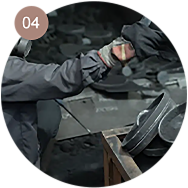
Exploring the Versatility of Dutch Ovens and Braisers for Culinary Adventures
The Versatility of Dutch Ovens and Braisers
When it comes to kitchen cookware, few items are as beloved as the Dutch oven and the braiser. These durable, heavy-duty vessels have become staples in homes around the world, thanks to their versatility, heat retention, and ability to produce mouthwatering meals. Whether you're preparing a hearty stew, slow-cooked braised meats, or even baking bread, these pots are up to the task. Let’s delve into the characteristics and advantages of Dutch ovens and braisers, along with some tips on how to use them effectively.
Understanding Dutch Ovens and Braisers
Both Dutch ovens and braisers are designed for slow cooking, but they have some distinct differences. A Dutch oven is typically deep, with tall sides and a heavy lid, making it suitable for stews, soups, and bread baking. They are often made of cast iron, which retains heat excellently and distributes it evenly. Enamel-coated versions are popular as they are easier to clean and don't require seasoning like bare cast iron.
Braisers, on the other hand, usually have a wider surface area and shorter sides. They often come with a tight-fitting lid and are perfect for browning meat and then adding liquid for braising. The wide base allows for greater evaporation, which helps in developing richer flavors in sauces and gravies.
The Benefits of Using Dutch Ovens and Braisers
1. Heat Retention and Distribution One of the biggest advantages of using cast iron cookware is its ability to retain heat. This means that your food will cook evenly, whether you’re simmering sauces, baking, or frying.
2. Versatility These pots can transition seamlessly from stovetop to oven, allowing you to start your dish on the stove for browning and then finish cooking it in the oven. This is particularly useful for one-pot meals where you want to develop deep flavors without multiple dishes.
3. Durability With proper care, a Dutch oven or braiser can last a lifetime and even be passed down through generations. Unlike non-stick pans that wear out over time, cast iron cookware is incredibly tough and becomes even more effective as it ages, especially with seasoning.
dutch ovens and braisers

4. Aesthetic Appeal Many Dutch ovens and braisers come in a variety of colors and designs, making them beautiful enough to serve directly from the pot to the table. This not only enhances the dining experience but also saves on dishwashing.
Cooking Tips with Dutch Ovens and Braisers
- Preheating Always preheat the pot before adding oil or ingredients. This helps to ensure a good sear and prevents food from sticking.
- Avoid High Heat While cast iron can handle high temperatures, it's best to avoid them to prevent burning and warping. Moderate to low heat is often sufficient, especially for braising.
- Use Lid Heavyweights When braising, make sure the lid fits tightly, as this helps to keep moisture in. A heavy lid will aid in creating a steam effect during cooking, vital for tenderizing meats.
- Seasoning If you’re using a bare cast iron Dutch oven, remember to regularly season it with oil to maintain its non-stick surface and prevent rust.
- Experiment with Recipes Don’t hesitate to try different recipes from various cuisines. From classic French coq au vin to the perfect chili, the possibilities are endless.
In conclusion, Dutch ovens and braisers are invaluable additions to any kitchen. Their ability to create delicious, hearty meals with minimal fuss makes them a go-to choice for both novice cooks and seasoned chefs. With a bit of practice and creativity, you can unlock the full potential of these versatile cookware pieces and elevate your culinary creations to new heights. Whether you’re simmering soups on a cold winter night or preparing a festive feast, a Dutch oven or braiser will undoubtedly stand by your side, reflecting the love you pour into every dish.
-
Season Cast Iron Perfectly with GPT-4 Turbo TipsNewsAug.01,2025
-
High Quality Cast Iron Cookware - Baixiang County Zhongda MachineryNewsAug.01,2025
-
Premium Cast Iron Pan: Durable & Perfect HeatNewsAug.01,2025
-
High Quality Kitchen Durable Black Round Cast Iron Cookware Pancake Crepe Pan-Baixiang County Zhongda Machinery Manufacturing Co., Ltd.NewsAug.01,2025
-
Cast Iron Cookware - Baixiang County Zhongda Machinery | Nonstick, Heat ResistanceNewsAug.01,2025
-
High Quality Kitchen Durable Black Round Cast Iron Cookware - Baixiang County Zhongda Machinery | Non-Stick, Heat Retention, DurableNewsJul.31,2025


